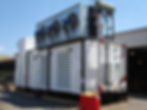Choosing a Power Enclosure: Expert Guide to the Best Generator & Custom Solutions
- Enercon
- Aug 13
- 3 min read
How to Select the Proper Power Enclosure for Your Application
When your operation relies on uninterrupted power—whether you're operating a mission-critical defense system, keeping a data center running, or powering remote utility infrastructure—the enclosure that houses your equipment isn't just a box. It's a shield, a climate manager, and in some instances, a life-extending investment for the systems within.
Choosing a power enclosure is more than choosing something that looks right on a spec sheet. Good design safeguards performance, ensures compliance, and maximizes uptime—even in the harshest environments.
A power enclosure contains and safeguards essential electrical gear such as generators, switchgear, and control panels. Its function is fundamental: regardless of the sophistication of your equipment, if the enclosure is compromised, the system is compromised.
Critical Considerations when Choosing a Power Enclosure

1. Environment
Where and how your equipment operates determines what your enclosure needs to handle.
Indoor vs. outdoor: Outdoor enclosures require weatherproofing, UV resistance, and corrosion protection.
Climatic challenges: Hot, cold, humid, or salt-air conditions require special coatings, ventilation, or insulation.
Seismic or wind hazards: Imperative for earthquake- or hurricane-prone areas; the structure's strength and compliance with wind loads are relevant.
2. Mobility
Is your application stationary, or does it have to move?
Stationary: Ideal for permanent installations; may allow for larger, more complex designs.
Portable: Light but sturdy design for regular relocation.
Containerized: ISO shipping container-based units allow easy transport and deployment worldwide.

3. Compliance
Meeting the right standards is non-negotiable.
Noise ordinances: Urban or campus settings often require sound-attenuated designs.
EMI/EMP shielding: Extremely critical for defense or sensitive electronics applications.
Industry-specific codes: From NFPA to IEEE, compliance ensures safety and project approval.
4. Power Requirements
Size and internal organization affect everything from access to cooling.
Cooling and airflow: Proper ventilation or HVAC prevents overheating.
Future expansion: Space for upgrading reduces future replacement costs.
Load capacity: Balance enclosure rating and size with your future and current power requirements.
Industry Examples & Applications
Defense
Defense operations demand ruggedized enclosures that can survive transport, extreme climates, and hostile conditions. EMP/EMI shielding protects sensitive systems from interference or attack, while tamper-resistant designs protect against unauthorized access. High security is not optional—it’s mission-critical.
Data Centers
When uptime is money, the best generator enclosure for a data center will balance sound attenuation with robust weatherproofing. Walk-in enclosures offer easier maintenance, while containerized designs allow rapid deployment. Customizations for cable routing, airflow control, and site-specific noise or space constraints are often required.

Utilities & Energy
Utilities tend to be in remote or extreme environments. Reliability, weatherability, and deployability on a large scale are critical. Enclosures for this market can include built-in monitoring systems, special corrosion-resistant coatings, and designs that facilitate rapid field installation.
Custom vs. Standard: The Argument for a Custom Power Enclosure
A standard enclosure will suffice for many projects—but in defense, data center, and utility markets, among others, a tailored power enclosure is often the difference between readiness and costly downtime.
Personalized designs can include:
Improved noise reduction above normal levels
Advanced weatherproofing for severe climates
Walk-in service for easy service
Integrated monitoring and controls
High-security locks and tamper-resistant design
Integrated cable management and flexible routing options
When your functional requirements outstrip off-the-shelf capability, custom manufacturing ensures the enclosure is engineered precisely to your mission, environment, and compliance requirements.
Checklist: How to Choose the Perfect Generator Enclosure
Here is a quick decision-maker's checklist for selecting the perfect generator enclosure:
Define operational environment (temperature, weather, seismic/wind exposure)
Verify mobility requirements (stationary, portable, containerized)
Determine compliance requirements (EMI/EMP, noise, industry codes)
Match enclosure size to present and future power demands 5. Identify access requirements (walk-in vs. non-walk-in)
Choose material and coating depending on environment and durability objectives
Cooling and ventilation design (natural, HVAC, or hybrid)
Consider security features (locks, tamper-proof designs)
Implement monitoring systems for real-time performance data
Assess supplier experience with your particular industry issues

Conclusion
For mission-critical applications, the right power enclosure is more than a box—it's a vital system component that guards uptime, shields investments, and ensures compliance. With environment, mobility, compliance, and power needs in mind, you'll be led to the right fit, off-the-shelf or custom-designed.
Enercon Engineering has decades of experience designing and constructing enclosures for defense, data centers, utilities, and beyond. Our staff is familiar with the particular requirements of each industry and can design the optimal solution for your particular application.
Need help selecting a power enclosure? Contact our experts today to begin designing the ideal enclosure for your mission.
